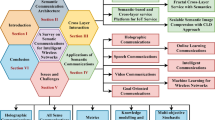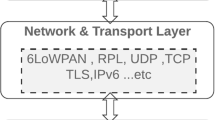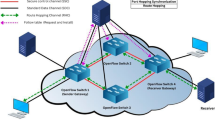Abstract
We present an efficient message delivery framework, called MeDeHa, which enables communication in an internet connecting heterogeneous networks that is prone to disruptions in connectivity. MeDeHa is complementary to the IRTF’s Bundle Architecture: besides its ability to store messages for unavailable destinations, MeDeHa can bridge the connectivity gap between infrastructure-based and multi-hop infrastructure-less networks. It benefits from network heterogeneity (e.g., nodes supporting more than one network and nodes having diverse resources) to improve message delivery. For example, in IEEE 802.11 networks, participating nodes may use both infrastructure- and ad-hoc modes to deliver data to otherwise unavailable destinations. It also employs opportunistic routing to support nodes with episodic connectivity. One of MeDeHa’s key features is that any MeDeHa node can relay data to any destination and can act as a gateway to make two networks inter-operate or to connect to the backbone network. The network is able to store data destined to temporarily unavailable nodes till the time of their expiry. This time period depends upon current storage availability as well as quality-of-service needs (e.g., delivery delay bounds) imposed by the application. We showcase MeDeHa’s ability to operate in environments consisting of a diverse set of interconnected networks and evaluate its performance through extensive simulations using a variety of scenarios with realistic synthetic and real mobility traces. Our results show significant improvement in average delivery ratio and a significant decrease in average delivery delay in the face of episodic connectivity. We also demonstrate that MeDeHa supports different levels of quality-of-service through traffic differentiation and message prioritization.



















Similar content being viewed by others
Notes
More details on the related work are presented in Sect. 6.
This work has been done at INRIA, Sophia Antipolis.
It is true that most current off-the-shelf APs do not typically come equipped with mass storage. We argue that adding this capability to next-generation APs is viable and will not considerably impact cost, especially if there is market demand. Furthermore, co-locating a general-purpose computing device with APs is another alternative given current AP technology.
Note that node G can use a single interface card to connect to two different networks [8], or it can be connected to a cellular base station and uses 802.11 card to connect to an ad-hoc network.
Note that following traditional epidemic routing, two nodes, upon encountering each other, exchange the list of all the messages each one stores. Since local storage is limited, typically messages have a Time-to-Live associated with them, beyond which they are discarded. To prevent waste of memory resources, each stored message has an expiry time associated to it. Moreover, buffer management and flow control mechanisms for DTN such as HBSD [20] can be employed to schedule message transmission during contact time.
These notifications are defined in Table 2.
The node does not remove the neighboring node’s entry from its contact table.
We recoginize that a longer-term naming solution is clearly needed. However, it is out of the scope of this paper and is being investigated as part of an ongoing work [28].
The source code of the MeDeHa framework and our experiments can be downloaded from the URL http://planete.inria.fr/Software/MeDeHa.
In our simulations, we assume that the APs have circular coverage areas. In practice, APs do not generally provide circular behavior. Changing APs coverage regions may change results obtained in this scenario, but has no effect on the functionality of MeDeHa qualitatively.
We used other values for average data rate from 1 to 160 messages/mn and observed similar performance trend.
For this scenario, we assume that, while moving, users have their devices on. In real scenarios, users may turn their devices (e.g.,laptops) off while moving. For such cases, message buffering in the nodes must use persistent storage. When considering devices that can be turned off, there will be less opportunities for message forwarding due to less number of relay nodes. This may reduce the PDR and increase the AD.
References
Sarafijanovic-Djukic, N., Piorkowski, M., & Grossglauser, M. (2006). Island hopping: Efficient mobility-assisted forwarding in partitioned networks. In Proceedings of IEEE SECON’06 (pp. 226–235).
Ott, J., Kutscher, D., & Dwertmann, C. (2006). Integrating DTN and MANET routing, In Proceedings of ACM SIGCOMM Workshop on Challenged Networks (CHANTS) (pp. 221–228). Pisa, Italy.
Vahdat, A., & Becker, D. (2000). Epidemic routing for partially connected ad-hoc networks, Technical Report CS-200006, Duke University.
Spyropoulos, T., Psounis, K., & Ragha Vendra, C. S. (2005). Spray and wait: An efficient routing scheme for intermittently connected mobile networks, In Proceedings of ACM SIGCOMM Workshops WDTN (pp. 252–259). Philadelphia, PA.
Chen, J.-C., Li, S., Chan, S.-H., & He, J.-Y. (2005). WIANI: Wireless infrastructure and ad-hoc network integration, In Proceedings of IEEE International Conference on Communications (ICC) (pp. 3623–3627). Seoul, Korea.
He, J., Chen, J., Chan, S.-H. G., & Liew, S.-C. (2003). Mixed-mode Wlan: The Integration of ad-hoc mode with wireless LAN infrastructure. In Proceedings of IEEE Globecom (pp. 231–235).
Parata, C., Convertino, G., Scarpa, V. (2007). Flex-WiFi: A mixed infrastructure and ad-hoc IEEE 802.11 network for data traffic in a home environment. In Proceedings of the First IEEE WoWMoM Workshop on Autonomic and Opportunistic Communications (AOC) (pp. 1–6). Finland.
Chandra, R., Bahl, P., & Bahl, P. (2004). MultiNet: connecting to multiple IEEE 802.11 networks Using a singleWireless card. In Proceedings of IEEE Infocom (pp. 882–893). Hong Kong.
Hamidian, A., Korner, U., & Nilsson, A. (2005). Performance of internet access solutions in mobile ad-hoc networks. Wireless Systems and Mobility in Next Generation Internet (pp. 189–201). Berlin: Springer.
Scott, K., & Burleigh, S. (2007). RFC 5050, Bundle Protocol Specifications, IRTF DTN Research Group, November.
Cerf, V., Burleigh, S., Hooke, A., Torgerson, L., Durst, R., Scott, K., Fall, K., & Weiss, H. (2007). RFC 4838, Delay-Tolerant Networking Architecture, IRTF DTN Research Group, April.
Zhao, W., Ammar, M., & Zegura, E. (2004). A message ferrying approach for data delivery in sparse mobile ad-hoc networks. In Proceedings of ACM/IEEE MOBIHOC (pp. 187–198). Japan.
Shah, R., Roy, S., Jain, S., & Brunette, W. (2003). Data MULEs: Modeling a three-tier architecture for sparse sensor networks. In Proceedings of IEEE Workshop on Sensor Network Protocols and Applications (SNPA) (pp. 30–41). Seattle, WA.
Zhao, W., Chen, Y., Ammar, M., Corner, M., Levine, B. N., & Zegura, E. (2006). Capacity enhancement using throwboxes in DTNs. In Proceedings of IEEE International Conference on Mobile Ad-hoc and Sensor Systems (MASS) (pp. 31–40). Canada.
Rais, R. N. B., Turletti, T., & Obraczka, K. (2008). Coping with episodic connectivity in heterogeneous networks In Proceedings of the 11th International Symposium on Modeling, Analysis and Simulation of Wireless and Mobile Systems (MSWiM). pp. 211–219. Canada.
Spyropoulos, T., Turletti, T., & Obraczka, K. (2009). Routing in delay tolerant networks comprising heterogeneous node populations. IEEE Transactions on Mobile Computing (TMC), 8(8), 1132–1147.
Grossglauser, M., & Vetterli, M. (2006). Locating mobile nodes with EASE: Learning efficient routes from encounter histories alone. IEEE/ACM Transactions on Networking, 14(3), 457–469.
Nelson, S., Bakht, M., & Kravets, R. (2009). Encounter-based routing in DTNs. In Proceedings of IEEE Infocom’09, Brazil.
Lindgren, A., Doria, A., & Scheln, O. (2004). Probabilistic routing in intermittently connected networks, Lecture Notes in Computer Science, Vol. 3126, pp. 239–254.
Krifa, A., Barakat, C., & Spyropoulos, T. (2008). Optimal buffer management policy for delay tolerant networks. In Proceedings of SECON, San Francisco, June, CA.
Raya, M., & Hubaux, J. P. (2007). Securing vehicular ad hoc networks. In Proceedings of Journal of Computer Security 15(1), 39–68.
Samuel, H., & Zhuang, W. (2009). Preventing unauthorized messages in DTN based mobile ad hoc networks. In Proceedings of IEEE Globecom (pp. 1–6).
Farrell, S., Symington, S. F., Weiss, H., & Lovell, P. (2009). Delay-tolerant networking security overview, Internet Draft, IRTF, September.
Bindra, H. S., & Sangal, A. L. (2010). Considerations and open issues in delay tolerant networks (DTN) security. In Proceedings of Wireless Sensor Network 2(8), 645–648.
Mendonca, M., Rais, R. N. B., Turletti, T., & Obraczka, K. (2010). Message delivery in heterogeneous disruption-prone networks, demo presentation in ACM Mobicom.
Rais, R. N. B., Mendonca, M., Turletti, T., & Obraczka, K. (2011). Towards truly heterogeneous networks: Bridging infrastructure-based and infrastructure-less networks. In Proceedings of 3rd IEEE/ACM International Conference on Communication Systems and Networks (COMSNETS) (pp. 1–10). India.
Network Simulator and Network Animator Project (NSNAM), Network Simulator 3 (ns-3), http://www.nsnam.org.
Rais, R. N. B., Abdelmoula, M., Turletti, T., & Obraczka, K. (2011). Naming for heterogeneous networks prone to episodic connectivity. In Proceedings of IEEE WCNC, Mexico.
Bettstetter, C., & Wagner, C. (2002). The spatial node distribution of the random waypoint mobility model. In Proceedings of the First German Workshop on Mobile Ad-Hoc Networks (WMAN), GI Lecture Notes in Informatics, Vol. 11, pp. 41–58.
Feeley, M., Hutchinson, N., & Ray, S. (2004). Realistic mobility for mobile ad-hoc network simulation, Ad-Hoc, Mobile, and Wireless Networks, Lecture Notes in Computer Science, Vol. 3158. Berlin: Springer.
BonnMotion, Univerysity of Bonn, A mobility scenario generation and analysis tool, http://web.informatik.uni-bonn.de/IV/Mitarbeiter/dewaal/BonnMotion.
Rhee, I., Shin, M., Hong, S., Lee, K., Kim, S., & Chong, S. (2009). CRAWDAD data set ncsu/mobilitymodels (v. 2009-07-23), Downloaded from http://crawdad.cs.dartmouth.edu/ncsu/mobilitymodels, July.
Author information
Authors and Affiliations
Corresponding author
Rights and permissions
About this article
Cite this article
Rais, R.N.B., Turletti, T. & Obraczka, K. Message delivery in heterogeneous networks prone to episodic connectivity. Wireless Netw 17, 1775–1794 (2011). https://doi.org/10.1007/s11276-011-0377-0
Published:
Issue Date:
DOI: https://doi.org/10.1007/s11276-011-0377-0




